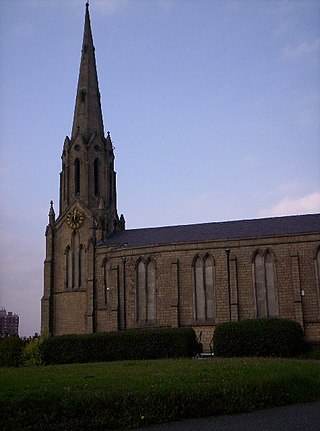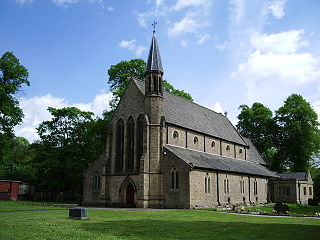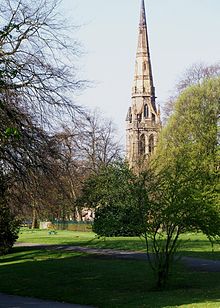
St Mark's Church is an active Anglican parish church in Worsley, Greater Manchester, England. It is part of a team ministry along with St Mary's in Ellenbrook and St Andrew in Boothstown. The church is in the Eccles deanery, the archdeaconry of Salford and the diocese of Manchester. The church was granted Grade I Listed status in 1966.

Edmund Sharpe was an English architect, architectural historian, railway engineer, and sanitary reformer. Born in Knutsford, Cheshire, he was educated first by his parents and then at schools locally and in Runcorn, Greenwich and Sedbergh. Following his graduation from Cambridge University he was awarded a travelling scholarship, enabling him to study architecture in Germany and southern France. In 1835 he established an architectural practice in Lancaster, initially working on his own. In 1845 he entered into partnership with Edward Paley, one of his pupils. Sharpe's main focus was on churches, and he was a pioneer in the use of terracotta as a structural material in church building, designing what were known as "pot" churches, the first of which was St Stephen and All Martyrs' Church, Lever Bridge.

Holy Trinity Church stands to the north of the village of Bickerton, Cheshire, England. The church is recorded in the National Heritage List for England as a designated Grade II listed building. It is an active Anglican parish church in the diocese of Chester, the archdeaconry of Chester, and the deanery of Malpas. Its benefice is combined with those of St Wenefrede, Bickley, St John, Burwardsley and All Saints, Harthill.

St Mary's Church is in Knowsley Lane, Knowsley Village, Merseyside, England. The church is recorded in the National Heritage List for England as a designated Grade II* listed building. It is an active Anglican parish church in the diocese of Liverpool, the archdeaconry of Liverpool and the deanery of Huyton. In the Buildings of England series, Pollard and Pevsner describe the church as being "largish" with "an intimate interior".

Christ Church is a former Anglican parish church, now redundant, at Weston Point Docks, Runcorn, Cheshire, England. It is recorded in the National Heritage List for England as a designated Grade II listed building.

St Paul's Church is in Scotforth, a suburb of Lancaster, Lancashire, England. It is recorded in the National Heritage List for England as a designated Grade II listed building. It is an active Anglican parish church in the deanery of Lancaster, the archdeaconry of Lancaster and Morecambe, and the diocese of Blackburn. The architectural historian Nikolaus Pevsner described it as a "strange building" and "an anachronism, almost beyond belief".

Holy Trinity Church stands in a country lane near the hamlet of Howgill, between Sedbergh and Tebay, Cumbria, England. It is an active Anglican church in the deanery of Kendal, the archdeaconry of Westmorland and the Anglican Diocese of Carlisle. The church is recorded in the National Heritage List for England as a designated Grade II listed building.

Holy Trinity Church is in Mount Pleasant, Blackburn, Lancashire, England. It is a former Anglican parish church which is now redundant and under the care of the Churches Conservation Trust. It is recorded in the National Heritage List for England as a designated Grade II listed building.

St George's Church is in Church Walk, Stalybridge, Greater Manchester, England. It is an active Anglican parish church in the deanery of Ashton-under-Lyne, the archdeaconry of Rochdale and the diocese of Manchester. The church is recorded in the National Heritage List for England as a designated Grade II listed building. It was a Commissioners' church, having received a grant towards its construction from the Church Building Commission.

St James' Church is in Church Street, Briercliffe, Lancashire, England. It is an active Anglican parish church in the deanery of Burnley, the archdeaconry of Blackburn and the diocese of Blackburn. The church is recorded in the National Heritage List for England as a designated Grade II listed building.

St Catharine's Church is in Lorne Street, Scholes, Wigan, Greater Manchester, England. It is an active Anglican parish church in the deanery of Wigan, the archdeaconry of Warrington and the diocese of Liverpool. Its benefice is united with that of Christ Church, Ince-in-Makerfield. The church is recorded in the National Heritage List for England as a designated Grade II listed building. It was a Commissioners' church, having received a grant towards its construction from the Church Building Commission.

Holy Trinity Church, Morecambe, or Morecambe Parish Church, is in Church Street, Morecambe, Lancashire, England. It is the Anglican parish church of Morecambe, in the deanery of Lancaster, the archdeaconry of Lancaster and the diocese of Blackburn. The church is recorded in the National Heritage List for England as a designated Grade II listed building.

St Stephen and All Martyrs' Church, Lever Bridge, is in Darcy Lever, Bolton, Greater Manchester, England. It is an active Anglican parish church in the deanery of Walmsley, the archdeaconry of Bolton, and the diocese of Manchester. The church is recorded in the National Heritage List for England as a designated Grade II* listed building, and is the first of three "pot churches" designed by Edmund Sharpe, so-called because they are constructed largely of terracotta.

Holy Trinity Church, commonly known as Horwich Parish Church, is a Grade II listed building in Horwich, Greater Manchester, England. It is an active Church of England parish church and part of the Deane deanery in the archdeaconry of Bolton, diocese of Manchester. Holy Trinity Church is now part of the United Benefice of Horwich and Rivington, which includes the other two Anglican churches in Horwich, St Catherine's Church and St Elizabeth's Church, and Rivington Anglican Church.

St Saviour's Church is in Ringley, Kearsley, near Bolton, Greater Manchester, England. It is an active Anglican parish church in the deanery of Bolton, the archdeaconry of Bolton and the diocese of Manchester. Its benefice is united with those of St Peter's, Farnworth, St John the Evangelist, Farnworth and Holy Trinity, Prestolee. The church is recorded in the National Heritage List for England as a designated Grade II listed building.

Holy Trinity Church, Northwich, is in the Castle district of Northwich, Cheshire, England. It is an active Anglican parish church in the deanery of Middlewich, the archdeaconry of Chester, and the diocese of Chester. Its benefice was united with that of St Luke, Winnington, Northwich until 2018 when the benefice was dissolved and Holy Trinity became a single parish again. The church is recorded in the National Heritage List for England as a designated Grade II listed building.

Holy Trinity Church, is in the village of Bolton-le-Sands, Lancashire, England. It is an active Anglican parish church in the deanery of Tunstall, the archdeaconry of Lancaster, and the diocese of Blackburn. Its benefice is united with that of St Mark, Nether Kellett. The church is recorded in the National Heritage List for England as a designated Grade II* listed building.

Immanuel Church is in the village of Feniscowles, near Blackburn, Lancashire, England. It is an active Anglican parish church in the deanery of Blackburn with Darwen, the archdeaconry of Blackburn, and the diocese of Blackburn. The church is recorded in the National Heritage List for England as a designated Grade II listed building.

Holy Trinity Church is a redundant Anglican parish church in New Church Lane, Ulverston, Cumbria, England. It is recorded in the National Heritage List for England as a designated Grade II listed building. It is a Commissioners' church, having received a grant towards its construction from the Church Building Commission.

All Saints Church is in Delph Lane, Barnacre-with-Bonds, Lancashire, England. It is an active Anglican parish church in the deanery of Garstang, the archdeaconry of Lancaster, and the diocese of Blackburn. Its benefice is united with those of St Peter, Scorton, and St John the Evangelist, Calder Vale. The church is recorded in the National Heritage List for England as a designated Grade II listed building.




























